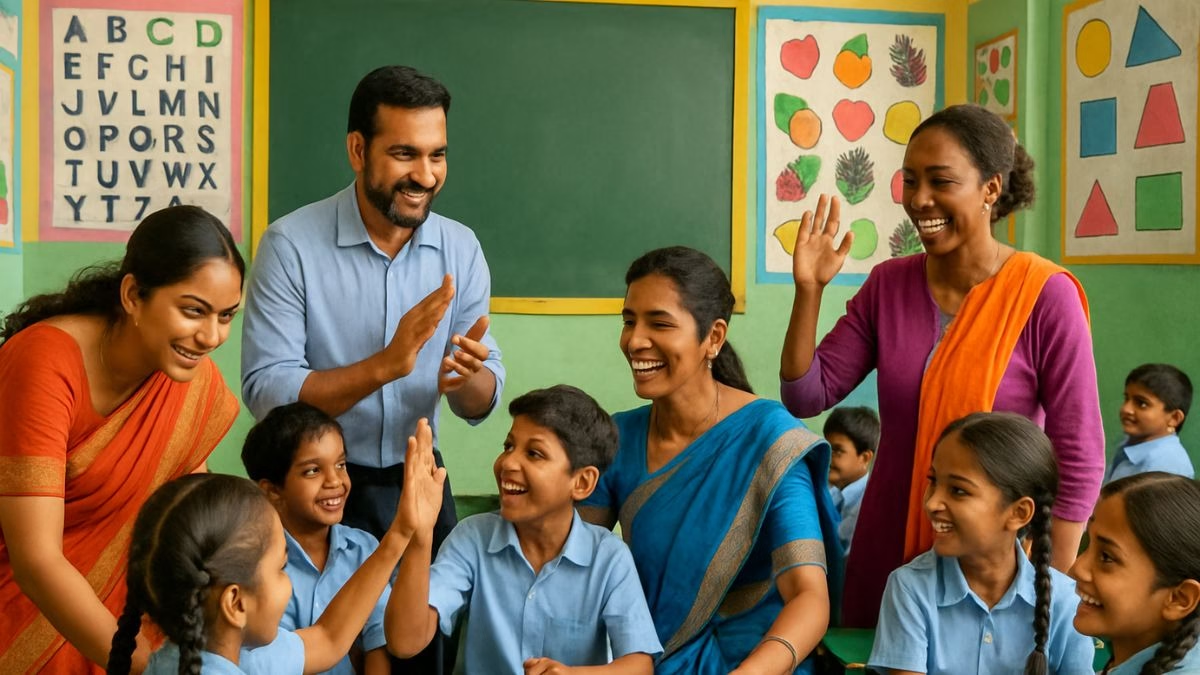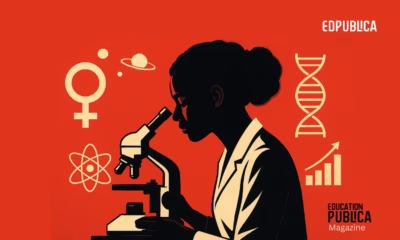EDUNEWS & VIEWS
Why We Must Challenge Stereotypes to Open Science Careers for Girls
Efforts should be made to raise awareness about the contributions of women in science and to challenge stereotypes that discourage girls from pursuing science careers

While there has been significant progress in increasing the participation of women in science-related disciplines, studies have confirmed that men continue to dominate science, technology, engineering, and mathematics (STEM) careers. Despite the gains in women’s participation in science careers in countries including South Africa, women remain underrepresented in these fields. This gender disparity is further heightened among Black women.
Although women represent the majority of young university graduates in South Africa, only 13% of STEM graduates are women, with Black women being significantly underrepresented in higher academic and research leadership positions. This can be attributed to systemic barriers such as gender bias, lack of mentorship, and limited access to resources, which continue to hinder true equality in science careers.
At our institution, the University of the Free State (UFS), there is an increasing commitment to support emerging researchers, especially women, through mentorship and research development opportunities. This is part of our institution’s Vision 130, which aspires to foster excellence in research and increase the impact of our scholars on the broader societal context. I am privileged to be one of the selected candidates in our institution’s Transformation of the Professoriate Mentoring Programme, which aims to grow a critical mass of excellent emerging scholars at the UFS. This programme equips all its candidates with both academic and research mentorship to advance their development towards assuming senior academic and research positions. More importantly, this programme supports candidates in accessing networking and funding opportunities, contributing to their establishment as researchers with the potential to create centres of research excellence in the future. My hope is that those of us who have access to such opportunities can also use our privilege and positions to mentor more women researchers from underrepresented groups in the various fields of science.
“Although women represent the majority of young university graduates in South Africa, only 13% of STEM graduates are women, with Black women being significantly underrepresented in higher academic and research leadership positions
To improve the participation of more women in science-related careers, it is crucial to address the systemic barriers that hinder their progress. This includes creating more mentorship and networking opportunities for women, providing financial support and scholarships for female students in science career fields, and implementing national policies that promote work-life balance and support for working mothers.
Additionally, efforts should be made to raise awareness about the contributions of women in science and to challenge stereotypes that discourage girls from pursuing science careers. Encouraging more inclusive and diverse work environments where women feel valued and supported is essential for increasing their participation and retention in science careers. There is also a need for progressive policies that promote the employment of Black women academics in positions of authority in STEM fields. This will ensure the availability of a diversity of women mentors and academics to offer gender-sensitive support to students.
(As told to Dipin Damodharan)
EDUNEWS & VIEWS
AI and Simulation Technologies Are Redefining Finance Classrooms Worldwide
Explore how AI and simulation-based learning are transforming finance and accounting education, bridging theory with real-world practice

The rapid expansion of digital technologies has profoundly transformed modern society. These advances have reshaped how individuals and institutions use technology to meet diverse needs and aspirations. Among the most impactful innovations is artificial intelligence (AI), which has catalysed social and educational transformations by simplifying complex challenges, enabling predictive simulations, and enhancing problem identification through modelling and scenario planning before decisions are made.
The COVID-19 pandemic further accelerated this digital transformation, compelling educational institutions to adopt online and hybrid learning models virtually overnight. This abrupt shift underscored the importance of digital competencies in accounting education while simultaneously revealing gaps in existing curricula and pedagogical methods.
AI now plays a pivotal role in teaching and learning across disciplines. Traditional classroom lectures and textbook exercises are increasingly being supplemented—or, in some cases, replaced—by AI-driven tools and interactive simulations. Collectively, these innovations are fostering a more immersive, adaptive, and forward-looking approach to financial education. In academic settings, AI facilitates rapid access to learning materials, delivers instant feedback, and supports autonomous learning, empowering students to achieve their academic goals more efficiently.
Artificial Intelligence–Driven Customisation in Financial Education
Despite growing recognition of the need for digitalisation in accounting education, a significant gap remains between the skills developed in academia and those demanded by industry. Finance and accounting disciplines are rooted in rigorous theoretical frameworks, quantitative analysis, and strict adherence to standards such as GAAP or IFRS. While textbooks and lectures provide foundational knowledge, they rarely reflect the complex and unpredictable decision-making environments that professionals face.
Students often experience limited exposure to market volatility, regulatory changes, and real-world uncertainty. Consequently, passive learning models that focus primarily on memorisation and theoretical understanding of topics such as risk management, portfolio optimisation, and forensic accounting are becoming less effective.
AI and simulation technologies are addressing this challenge by transforming classrooms into dynamic laboratories that mirror actual market and organisational contexts. The growing importance of sustainability reporting and integrated thinking further demands a technologically literate, systems-oriented approach to accounting education. Given the rapid evolution of the profession, it has become imperative to reassess and redesign finance and accounting curricula to prepare students for a digital-first future. However, a comprehensive understanding of how digitalisation reshapes learning outcomes and curricular design remains underdeveloped.
As early as the 1960s, educator Bert Y. Kersh developed a classroom simulator using films and stills to replicate classroom decision-making for pre-service teachers
AI-driven tools—such as ChatGPT, educational chatbots, Grammarly, Google Translate, and Microsoft Word’s intelligent features—are now ubiquitous in higher education. Their use must be critically evaluated, particularly in terms of data accuracy, transparency, and ethical implications.
Simulations: Bringing Theory into Practice
Simulation-based learning (SBL) serves as a bridge between academic theory and professional practice by recreating real-world environments and decision-making scenarios. In fields such as medicine and aviation, simulations have long been used to help students practise essential skills and solve complex problems safely. As early as the 1960s, educator Bert Y. Kersh developed a classroom simulator using films and stills to replicate classroom decision-making for pre-service teachers. A subsequent randomised control trial revealed that students trained through simulation reported higher self-efficacy and demonstrated “classroom readiness” three weeks ahead of their peers.
According to a 2023 report by the World Economic Forum, artificial intelligence is increasingly integral in accounting education, enhancing adaptive learning and student engagement.
In finance and accounting, simulation-based learning allows students to engage directly with financial instruments and business challenges, improving their proficiency in trading, budgeting, auditing, and decision-making. Virtual stock market trading, for example, enables students to manage portfolios using real-time or historical market data to understand risk, diversification, and market dynamics. Similarly, forensic accounting simulators expose learners to fraud examination and auditing techniques within controlled environments.
Comprehensive business simulations integrate finance, marketing, and operations, replicating complex decision-making processes and teamwork dynamics. These immersive exercises mimic the uncertainty and pressure of real-world financial contexts, helping students balance analytical precision with professional judgement. Moreover, because mistakes in simulations carry no real-world consequences, students can learn through trial and error—an invaluable process in developing professional competence and confidence.
Universities and professional training institutions worldwide are increasingly incorporating AI and simulation technologies into their curricula. Business schools, CPA training programs, and online finance courses now feature trading labs, AI-enabled auditing case studies, and gamified simulation platforms where students earn credit by solving complex, real-world problems.
Such experiential learning models align academic theory with professional practice, ensuring that graduates enter the workforce ready to thrive in a technology-driven economy. As digital disruption continues to reshape industries, these innovations hold the potential to produce not only skilled accountants and finance professionals but also visionary leaders equipped to navigate the complexities of the 21st-century financial landscape.
EDUNEWS & VIEWS
Teacher Strength in India Crosses One Crore for the First Time
India’s teacher count crosses one crore in 2024-25, improving pupil-teacher ratios and female participation amid changing student enrolment trends.

For the first time in India’s academic history, the total number of school teachers in the country has crossed the one crore mark in the academic year 2024-25. This milestone was highlighted in the Unified District Information System for Education Plus (UDISE+) report released by the Ministry of Education on school education.
According to the report, this represents a 6.7 percent increase in the teacher workforce compared to 2022-23. The data further reflects the scale of India’s education system, which now comprises nearly 15 lakh schools catering to over 24 crore students across the country.
The enrolment pattern shows that nearly 50 percent of students are studying in government schools, followed by 41 percent in private institutions, with the rest enrolled in government-aided schools. Encouragingly, female representation among teachers has risen to 54.3 percent, while girls’ enrolment has reached 48.3 percent.
Better student-teacher ratios and declining dropouts
One of the most significant improvements reported is in the Pupil-Teacher Ratio (PTR). At the foundational, preparatory, middle, and secondary levels, the ratios now stand at 10, 13, 17, and 21 respectively, showing marked progress in easing classroom loads for teachers.
The Ministry also reported steady gains in dropout rates, student retention, and Gross Enrolment Ratios, indicating that schools are doing more to support students and keep them in the education system. Special attention has also been given to phasing out zero-enrolment and single-teacher schools, with better infrastructure additions enhancing the overall schooling environment.
Highlighting the broader significance of these trends, the Education Ministry stated that the growing teacher workforce is a critical step in ensuring equitable access and quality in education. Increased teacher availability is expected to improve classroom engagement, reduce regional disparities, and help address learning gaps. Schools, the report noted, are now becoming “more supportive and responsive to students’ needs,” which has also contributed to a reduction in early dropouts and greater inclusivity.
With the teacher count crossing the one-crore landmark and school indicators showing a positive trajectory, the government emphasized that the coming years will focus on consolidating these gains and ensuring that every child in India has the opportunity to access quality education.
Currently, India’s school system serves around 24.7 crore students across approximately 14.7 lakh schools, aligning closely with official numbers but reflecting a slight decline in enrolment compared to previous years. The overall student enrolment in 2024-25 marks a seven-year low, falling by about 11 lakh students compared to 2023-24. This drop is notably pronounced at the primary level (classes 1 to 5), which alone saw a decline of roughly 34 lakh students from the previous academic year. Key states like Uttar Pradesh, Bihar, Rajasthan, West Bengal, and Maharashtra reported some of the steepest enrolment declines, contributing to this national trend.
Government schools now account for about 50 percent of enrolment, though some states have witnessed a significant shift of students from government to private schools. This shift has raised concerns about the government’s capacity to retain students in public schools, with efforts underway to address infrastructural and quality gaps.
On the positive side, there has been progress in girls’ education with girls’ enrolment hovering near 48 percent nationally. The Net Enrolment Ratio (NER) for girls at primary education stands at approximately 90 percent, indicating a high level of age-appropriate enrolment. The secondary and higher secondary levels have shown improvement as well, aligning with the National Education Policy’s target of universal enrolment by 2030.
EDUNEWS & VIEWS
India’s Dhirubhai Ambani School Ranked Among Top Global Highschools
Founded in 2003, India’s Dhirubhai Ambani International School is also one of the youngest schools to feature in the rankings.

India’s Dhirubhai Ambani International School in Mumbai continues to shine on the global education stage, ranking fifth among schools outside the US and UK in the 2025 HSBC Hurun Education Global Highschools list. Founded in 2003, it is also one of the youngest schools to feature in the rankings.
The report emphasizes schools’ performance based on alumni university destinations, co-curricular development, and institutional reputation. With 190,000 students across the 180 ranked schools, only 0.6% of those listed are from India, underscoring the school’s elite standing.
In a media statement, Rupert Hoogewerf stated, “The list recognizes schools adding the most value to students’ futures. India’s presence through DAIS highlights the global competitiveness of select institutions in the country.”
Dhirubhai Ambani School joins a select group that includes Seoul International School, Chinese International School (HK), and Kolej Tuanku Ja’afar (Malaysia) in representing Asia outside China.
-

 Space & Physics6 months ago
Space & Physics6 months agoIs Time Travel Possible? Exploring the Science Behind the Concept
-

 Know The Scientist6 months ago
Know The Scientist6 months agoNarlikar – the rare Indian scientist who penned short stories
-

 Know The Scientist5 months ago
Know The Scientist5 months agoRemembering S.N. Bose, the underrated maestro in quantum physics
-

 Space & Physics3 months ago
Space & Physics3 months agoJoint NASA-ISRO radar satellite is the most powerful built to date
-

 Society5 months ago
Society5 months agoAxiom-4 will see an Indian astronaut depart for outer space after 41 years
-

 Society5 months ago
Society5 months agoShukla is now India’s first astronaut in decades to visit outer space
-

 Society5 months ago
Society5 months agoWhy the Arts Matter As Much As Science or Math
-

 Earth5 months ago
Earth5 months agoWorld Environment Day 2025: “Beating plastic pollution”


















